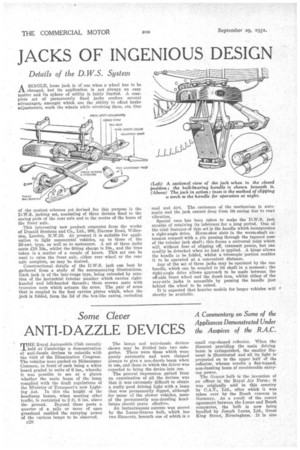JACKS OF INGENIOUS DESIGN
Page 50

If you've noticed an error in this article please click here to report it so we can fix it.
Details of the D.W.S. System
ASINGLE, loose jack is of use when a wheel has to be changed, but its application is not always an easy matter and its sphere of utility is fairly limited. A complete set of permanently fixed jacks confers several advantages,. amongst which are the ability to effect brake adjustments, wash the wheels while revolving them, etc. One
of the neatest schemes yet devised for this purpose is the D.W.S. jacking set, consisting of three devices fixed to the spring pads of the rear axle and to the centre of the beam of the front axle.
This interesting new product emanates from the works of Donald Sessions and Co., Ltd., 906, Harrow Road, Willesden, London, N.W.10. At present it is suitable for application to light commercial vehicles, up to those of the 30-cwt. type, as well as to motorcars. A set of three jacks costs 110 10s., whilst the fitting charge is 10s., and the time taken is a matter of a couple of hours. This set can be used to raise the front axle, either rear wheel or the rear axle complete, as may be desired.
Constructional details of the D.W.S. jack can best be gathered from a study of the accompanying illustrations. Each jack is of the lazy-tongs type, being extended by rotation of the horizontal tubular member which carries righthanded and left-handed threads; these screws mate with trunnion nuts which actuate the arms. The pair of arms that is coupled to the foot carries plates which, when the jack is folded, form the lid of the box-like casing, excluding mud and dirt The. enclosure of the mechanism is automatic and the jack cannot drop from its casing due to road vibration.
Special care has been taken to make the D.W.S. jack capable of retaining its lubricant for a long period. One of the vital features of this set is the handle which incorporates a right-angle drive. Horse-shoe slots in the worm-shaft extension connect with a pin passing through the tapered nose of the tubular jack shaft; this forms a universal joint which will, without fear of slipping off, transmit power, but can readily be detached when no load is applied. A hinge allows the handle to be folded, whilst a telescopic portion enables it to be operated at a convenient distance.
Any of the set of three jacks may be operated by the one handle, which can be coupled to ill shaft in a moment ; the right-angle drive allows approach to be made between the off-side front wheel and the dumb iron, whilst either of the rear-axle jacks is accessible by passing the handle just' behind the wheel to be raised.
It is expected that heavier models for larger vehicles will shortly be available.












































































































